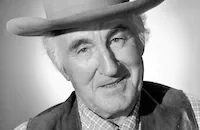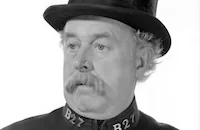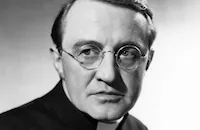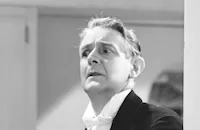National Velvet

Brief Synopsis
Cast & Crew
Clarence Brown
Mickey Rooney
Donald Crisp
Elizabeth Taylor
Anne Revere
Angela Lansbury
Film Details
Technical Specs

Synopsis
In the English coastal village of Sewels in Sussex, twelve-year-old Velvet Brown and her older sisters, Edwina and Malvolia, happily finish their last day of school before summer vacation. While walking home, Velvet meets young drifter Mi Taylor and strikes up a conversation with him. As the horse-crazy girl is talking to Mi, she sees a beautiful, rambunctious gelding being chased by its owner, farmer Ede, and is awestruck. When Ede then questions Mi about his business in Sewels in Sussex, Velvet, who is impressed by Mi's knowledge of horses, insists that he has been invited to dine with her family. That evening at dinner, Mrs. Brown asks Mi, whom she has never before met, about an address book with her name written in it, and he reveals that it belonged to his now-deceased father. Although Mrs. Brown is deliberately secretive about her relationship with Mi's father, she does invite Mi to spend the night in the stable. Velvet then tries in vain to convince her father Herbert, a butcher who prides himself on his thrift and self-control, to hire Mi as a delivery boy. When he and his wife discuss the matter later, however, the wise, persuasive Mrs. Brown easily changes his mind. Later, Velvet confesses to her mother that she has "fallen in love" with The Pie and asks her about Mi's father. Mrs. Brown, a former swimmer, reveals that when she was twenty, Mi's father was her devoted trainer and inspired her to swim the English Channel, a feat never before accomplished by a woman. Mrs. Brown adds that she declined to tell the obviously embittered Mi about his father because she felt that it was not the proper time to do so. Unaware that he has just stolen all of her mother's savings from the kitchen, Velvet rushes to tell Mi the news about his new job and home. Mi covers up his theft and accepts the job, then, chagrined, sneaks back to the kitchen to return the money. Later, Velvet coaxes Mi into taking her on a delivery to farmer Ede's, and on the way, Mi states that he was once thrown by a horse and now hates them. As they are watching The Pie in the field, the horse jumps Ede's wall and dashes off toward town. After estimating the length of the horse's jump, the astounded Mi mutters that The Pie could jump "Beecher's Brook." The Pie's subsequent rampage through the village leads Ede to decide to raffle off the horse. Mr. Brown at first refuses to allow Velvet to participate in the raffle, but when Mi proudly announces that he has bought tickets for all of the children, Mr. Brown relents. Although Velvet confidently proclaims that her number, 62, is going to be selected, another number is drawn, and Velvet collapses with disappointment. Later, however, Velvet learns that when the winning number was not claimed, a second number, 62, was drawn, and she is awarded The Pie. Velvet then asks Mi about "Beecher's Brook" and he reluctantly reveals that it is a difficult jump at the Grand National Steeplechase course. Velvet spends her first day with The Pie racing through the countryside, but her joy is cut short when her father insists that the horse earn his keep by pulling the delivery cart. As soon as he is hitched, however, The Pie bolts and destroys the cart, causing Mr. Brown to denounce Mi as a meddler. Later, Velvet reveals to Mi that she wrote away to the Aintree race course for entrance papers to the Grand National Steeplechase. Although Mi tries to discourage her, Velvet asks her mother for permission to enter the race, which includes a 100-pound entrance fee. After Mi admits that The Pie is good enough to win, Mrs. Brown gives Velvet the 100 pounds she earned for her Channel swim, which she has been saving in anticipation of a "breath-taking piece of folly" like The Pie. Mrs. Brown and Velvet then entrust Mi to deliver the money to Aintree, and although he is tempted to abscond with it while in London, Mi carries out his assignment, impressing even Mr. Brown. When Mi tells Velvet that he was unable to find a jockey or a trainer in London, she persuades him to train the horse by promising him one-half of any Grand National winnings. Over the next several months, Velvet and Mi, a former jockey, rigorously train The Pie. During the winter, The Pie becomes seriously ill, and the entire Brown family worries as Mi struggles to save him. The Pie survives, and come spring, Velvet and Mi leave for Aintree. There they meet with Ivan Taski, a Latvian jockey whom Mi hired through the mail. Taski's lackluster attitude toward the race convinces both Velvet and Mi that they cannot win with him, and on the eve of the contest, they find themselves with no jockey. Velvet then tries to convince Mi to ride The Pie, but he tearfully refuses, explaining that during a race in Manchester, he pushed his horse too hard and caused a collision that resulted in the death of another jockey. Later, however, when Mi is alone with The Pie, he realizes he must challenge his fears in order to make Velvet's dream come true. After riding The Pie around the track, Mi rushes to tell Velvet that he wants to race, but discovers that she has donned jockey clothes and is determined to ride the race herself. Although Mi tells her that she will be disqualified, Velvet insists that Mi cut her hair and help her with her impersonation. Claiming not to speak English, Velvet convinces the officials that she is Taski and undertakes the arduous race, with The Pie at one-hundred-to-one odds. As horse after horse drops out, Velvet steadily gains ground and wins the race, cheered on by a joyful Mi. Just after finishing, however, Velvet collapses from exhaustion, and the track doctor soon discovers her true sex. As predicted, The Pie is disqualified, but Velvet is nonetheless heralded as a hero throughout England and earns the nickname "National Velvet." Later, back in Sewels in Sussex, Velvet is besieged by lucrative job offers, including one from a Hollywood film studio. Velvet is tempted by the offer until she learns that the studio also wants The Pie. Fearing that The Pie would be made into a sideshow, Velvet tells her father she is not interested. Mr. Brown is angered by Velvet's decision until Mrs. Brown explains that Velvet knows intuitively that her time in the limelight must be brief and dignified. Soon after, as Mi is packing to go, Mr. Brown admits that he always mistrusted him, but is now proud to have known him. Mi leaves the Brown home without saying goodbye, but a grateful Velvet races after him, sure that the proper time has come to tell him about his father.

Director

Clarence Brown
Cast

Mickey Rooney

Donald Crisp

Elizabeth Taylor

Anne Revere

Angela Lansbury

Jackie Jenkins

Juanita Quigley

Arthur Treacher

Reginald Owen
Norma Varden

Terry Kilburn

Arthur Shields
Aubrey Mather
Alec Craig
Eugene Loring
Dennis Hoey
Matthew Boulton
Gerald Oliver Smith
King Charles, A Horse
Frederic Worlock
Harry Allen
Rene Austin
Jane Isbell
Virginia Mcdowall
Gail Peyton
Iris Kirksey
Bertha Stinchfield
Felicity Bilbrook
Paula Allen
Rhoda Williams
Beverly Billman
Stephen Rowson
Harold Debecker Jr.
Richard Haydel
Howard Taylor
Murray Coombs

Billy Bevan
Barry Macollum
Leland Hodgson

Leonard Carey
Barry Bernard
Colin Campbell
Frank Benson

Wally Cassell
Alec Harford
William Austin
Olaf Hytten
George Kirby
Ada Ellis
Stanley Mann
Frank Baker
Doris Stone
Lotus Thompson
Al Ferguson
Jack Lee
Wallis Clark
John Rogers
William Bailey
Rose Langdon
Arthur Blake

Charles Irwin

Donald Curtis
Gordon Richards
Joy Harrington
Wilbur Mack
Arthur Gould-porter
Major Douglas Francis
Eric Wilton
Moyna Macgill
Crew
Pandro S. Berman
Joseph Boyle
Clarence Brown
Earl Cates
Mark Davis
Jack Dawn
Kay Dean
Helen Deutsch
Howard Dimsdale
Cedric Gibbons
A. Arnold Gillespie
Robert Gough
Mildred Griffiths
Egon Heep
Irene
Henri Jaffa
Natalie Kalmus
Robert J. Kern
Urie Mccleary
M. J. Mclaughlin
Warren Newcombe
Theodore Reeves
William J. Saracino
Douglas Shearer
Robert W. Shirley
Leonard Smith
Newell Sparks
Michael Steinore
Herbert Stothart
Valles
Charles E. Wallace
Edwin B. Willis

Photo Collections
Videos
Movie Clip





Trailer
Hosted Intro





Film Details
Technical Specs

Award Wins
Best Editing
Best Supporting Actress
Award Nominations
Best Art Direction
Best Cinematography
Best Director
Articles
National Velvet
Despite Brown's eventual enthusiasm for his budding star, he had agreed with the early assessment of producer Pandro S. Berman and studio head Louis B. Mayer when National Velvet was being cast in late autumn of 1943 that Elizabeth was then too small, too short and too immature for the role of Velvet Brown. The heroine of the much-loved Enid Bagnold novel, who adores an unruly stallion and rides him to victory in England's Grand National, had to be tall and robust enough to pose as a male jockey, yet sufficiently developed to suggest that she is on the cusp of womanhood. As Lucille Ryman Carroll, then head of MGM's talent department, reportedly told then-11-year-old Elizabeth, "The part calls for a girl who is just beginning to blossom and she needs little bosoms, and you are -- well, like a little boy."
But no one at the studio realized the depth of the Taylor determination. Little Elizabeth, whose appearances in MGM films had been limited to bits in Lassie Come Home (1943) and The White Cliffs of Dover (1944), had fallen in love with the character of Velvet and embarked on a program to "grow into the role." Legend has it that between October and December of 1943 she added three inches to her height through a diet high in protein and carbohydrates and an exercise regimen that included swimming, horseback riding and hanging from a bar to stretch her spine. Also, as Elizabeth proudly announced to Carroll upon her return to the studio around Christmastime, "I now have boobs!"
Born in England, Taylor had the right accent, and certainly the fervor, to play Velvet convincingly. Under Brown's patient guidance, she gave a performance of great spirit and charm that set her on the path to international superstardom. National Velvet won a total of five Academy Award nominations, including one for Brown as Best Director; and two Oscars -- for Anne Revere as Best Supporting Actress as Velvet's understanding mother and Robert Kern for Film Editing. (Kern's work in the climactic race is still considered a classic of editing.) After the winners had been announced, an Academy spokesman said that Taylor had narrowly missed winning a special Oscar for best juvenile performance -- an award that went instead to Peggy Ann Garner for A Tree Grows in Brooklyn (1944).
Producer: Pandro S. Berman
Director: Clarence Brown
Screenplay: Helen Deutsch, Theodore Reeves, from novel by Enid Bagnold
Cinematography: Leonard Smith
Art Direction: Cedric Gibbons, Urie McCleary
Original Music: Herbert Stothart
Editing: Robert J. Kern
Costume Supervision: Irene
Principal Cast: Mickey Rooney (Mi Taylor), Donald Crisp (Mr. Brown), Elizabeth Taylor (Velvet Brown), Anne Revere (Mrs. Brown), Angela Lansbury (Edwina Brown), Jackie "Butch" Jenkins (Donald Brown), Juanita Quigley (Malvolia Brown).
C-124m. Closed captioning. Descriptive Video.
by Roger Fristoe

National Velvet
Quotes
What's the meaning of goodness if there isn't a little badness to overcome?- Mrs. Brown
I want it all quickly 'cause I don't want God to stop and think and wonder if I'm getting more than my share.- Velvet Brown
That'll be a dispute to the end of time, Mr. Brown: whether it's better to do the right thing for the wrong reason or the wrong thing for the right reason.- Mrs. Brown
Some day you'll learn that greatness is only the seizing of opportunity -- clutching with your bare hands 'til the knuckles show white.- Mi Taylor
So you're to win the gelding, are you Velvet?- Mr. Hallam
Oh, of course I'm to win.- Velvet
There are ways of arranging it, aren't there? And your father's a clever man...- Mr. Hallam
Oh, I didn't bother him, Mr. Hallam. I just arranged it with God.- Velvet
Trivia
Producer 'Pandro Berman' originally did not think that 'Elizabeth Taylor' was right for the role due to the young actress's lack of physical development. In addition to riding lessons, she began eating more and doing "chest enlargement exercises". By the time the casting decisions were made, Nature had given young Miss Taylor the necessary inches.
After production was completed, arrangements were made to allow Elizabeth Taylor ro keep the horse.
Notes
Contemporary sources add the following information about the production: In 1935, Paramount Pictures acquired the rights to Enid Bagnold's novel, besting RKO producer Pandro S. Berman, who was reportedly seeking the property as a vehicle for Katharine Hepburn. Leatrice Joy Gilbert, John Gilbert's daughter, was being considered by Paramount for the lead at that time, but because of casting difficulties, Paramount sold the rights to M-G-M in 1937. M-G-M planned to make the film in England with Hunt Stromberg as producer, and in June 1937, tested Leslie Ruth, actor Leslie Howard's daughter, for the role of "Velvet." In March 1938, Spencer Tracy was announced as a possible star, and in May 1939, "Suicide," a well-known jumping horse, was sought for the film. With the outbreak of war in Europe, the project was shelved, until 1941, when Berman, now an M-G-M producer, revived it. In early 1943, M-G-M undertook an extensive search for a female lead and sent a scout to Canada to test actresses who could convincingly play a teenage English girl. Billy Grady scouted Broadway actresses in late February 1943. Patsy Lee Parsons, Pat Arno and Alix de Kauffman were among the actresses who were tested for "Velvet." Sara Allgood was tested for a major character role in July 1943, but was not cast.
In early November 1943, Clarence Brown took over direction of the picture from Mervin LeRoy after Brown signed a new contract, agreeing to stay with M-G-M. Judith Anderson was tested for a role in mid-November 1943. At the same time, Brown was scouting Southern California and Arizona horse ranches for locations and horses. In December 1943, Brown was reportedly working on a final polish of the script, and was expanding the role of child actor Jackie Jenkins, with whom he had recently worked on The Human Comedy (.) "King Charles," the horse who played The Pie, and his equine stand-in traveled in a special truck designed by Brown. Six weeks of location shooting was done on the coast near Monterey, CA, while scenes depicting the Aintree Racetrack were shot at the Uplifters' Ranch and at the Midwick Country Club in Alhambra, CA. Hollywood Reporter reported in late September 1944 that, as an experiment, Brown was going to delete all background music and noise from the final race sequence. The completed scene, however, does contain background noise. Although Robert Coleman, Jimmy Aubrey, George Davis and Mona Freeman were announced as cast members in Hollywood Reporter, their appearance in the completed film has not been confirmed. Howard Taylor, who plays a schoolboy in the film, is Elizabeth Taylor's brother, while Moyna MacGill, who appears in a walk-on role in the picture, was Angela Lansbury's mother. National Velvet marked the first film in which Lansbury and her mother appeared together.
Although not her debut film, National Velvet marked Elizabeth Taylor's first major screen role and is considered by critics to be the film that propelled her into stardom. Many reviewers commented on her performance in the picture. The Daily Variety reviewer announced that Taylor "is fated for a great name in pictures," while the Hollywood Reporter critic commented that "stardom is inevitable for her." Bosley Crowther of the New York Times wrote that Taylor's "face is alive with youthful spirit, her voice has the softness of sweet song and her whole manner in this picture is one of refreshing grace." In her autobiography, Taylor claimed that after M-G-M renewed its interest in the story, she was called into Berman's office for an interview. Although the eleven-year-old Taylor, who spent her early childhood in England, spoke easily with an English accent and had been riding horses since she was three, Berman felt she was too short and slight to make a convincing Velvet. Determined to get the role, Taylor announced that she would "grow up" in time for the production, and began eating huge "farm breakfasts" every morning for three months. According to her autobiography, Taylor did, in fact, grow three inches and, after agreeing to a long-term contract with the studio, was awarded the part. Fred Zinnemann directed her screen test, according to Hollywood Reporter. Taylor said of the film: "I think Velvet is still the most exciting film I've ever done. And at the end, to be given the horse on my thirteenth birthday-well, it was one of the moments of my life." Taylor performed her own riding in the picture and commented in her autobiography that "she was the only person who could ride him [King Charles]." (According to modern sources, Taylor was thrown by the horse during filming and suffered a life-long back injury.)
National Velvet was nominated for Academy Awards in the following categories: Best Direction, Best Art Direction (Color) and Best Cinematography (Color). Anne Revere won the Oscar as Best Supporting Actress, while Robert J. Kern won for Best Film Editing. Kern's editing of the final steeplechase sequence earned him special notice by critics; the Newsweek critic raved that the racing scene was among the most memorable in film history. In June 1945, National Velvet became one of the first films to be selected by the Library of Congress for their motion picture collection. According to a New York Times article, the film was chosen because it faithfully recorded, in one way or another, "'the contemporary life and tastes and preferences of the American people.'"
On February 3, 1947, Taylor and Rooney reprised their roles from National Velvet for a Lux Radio Theatre broadcast, and on October 6, 1949, the Hallmark Playhouse broadcast a version starring Roddy McDowell. Bryan Forbes directed Tatum O'Neal, Nanette Newman, Christopher Plummer and Anthony Hopkins in a 1978 sequel to National Velvet called International Velvet. In the British-made sequel, O'Neal plays the grown Velvet's (Newman's) niece, who dreams of racing her horse in the Olympics. A television series based on National Velvet, also titled National Velvet, aired on the NBC network from September 18, 1960 to September 10, 1962. Lori Martin played Velvet in the series, and Arthur Space played her father.

Miscellaneous Notes
Released in United States April 1945
Released in United States July 1984
Released in United States Winter January 1, 1944
Selected in 2003 for inclusion in the Library of Congress' National Film Registry.
Released in USA on laserdisc December 6, 1988.
Released in United States Winter January 1, 1944
Released in United States April 1945
Released in United States July 1984 (Shown at FILMEX: Los Angeles International Film Exposition (50 Hour Sports Movie Marathon) July 5-20, 1984.)














